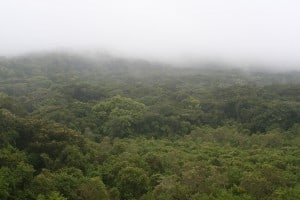Share this article
Deadly chytrid fungus detected in Central Africa
When David Blackburn went to the Central African country of Cameroon as a graduate student in 2004 and then again in 2006, he saw spectacular views of mountains and lakes — and frogs, every which way he looked.
He even discovered a bright red frog as part of his fieldwork on Mt. Manengouba and named it Cardioglossa manengouba. “The first time I went, the frog diversity I found was overwhelming,” said Blackburn, an associate curator of herpetology at the Florida Museum of Natural History and coauthor of a recent study published in PLOS ONE.
But just 10 years later, things appear to have changed. Blackburn’s colleagues recently returned with graduate students to further study the frogs in the region including the bright red frogs and found that populations had dwindled. In fact, the frogs that Blackburn would have seen once a day were now only visible about once a week. What was causing the decline?

High elevation forests on Mt. Manengouba.
©David Blackburn
“There’s no obvious explanation,” said Blackburn who, along with other researchers, conducted frog surveys in Cameroon’s Mt. Oku and Mt. Manengouba. What they did find, however, was that some frog species that were closely related to one another were declining.
While Cameroon has been pushing development and there has been habitat degradation from cattle grazing in or moving through wildlife habitat, nothing occurred during this short time period to suggest major declines — except for chytrid fungus (Batrachochytrium dendrobatidis), Blackburn says.
In the past decade, the deadly fungus, also referred to as Bd, which infects amphibians’ skin has emerged around the world in places such as the U.S., South America and Australia. Further, Blackburn’s colleagues found that the fungus was present in frogs in Mt. Oku in 2008 and was found in Mt. Manangouba in 2011. “This was the same time frame we started seeing declines,” he said. “This is certainly suggestive that chytrid is playing a role here.”
Blackburn says he and his colleagues are not sure why the fungus has likely emerged in Central Africa. However, factors such as climate change and habitat loss could be making some species more susceptible to it. In addition, Bd is likely spread when people transport frog species between countries. “It’s hard to pinpoint why it happened,” he said, “But we know it’s there now, and across Central Africa, there’s plenty of it.”
Conserving Cameroon’s Frogs
While researchers are looking for ways to treat the deadly fungus, Blackburn highlights methods that could potentially help individual frogs.
For instance, it’s important to control the way live animals are moved across borders. In fact, a recent revision to the U.S. Fish and Wildlife Service’s Lacey Act called for a ban in salamander trade to help prevent the spread of the Bsal fungus that’s similar to chytrid.
Blackburn also suggests educating local people about the region’s frog species — especially since there is a push to make the mountains a tourist spot — as well as the consequences of eliminating habitat.
“Now is the time for really thinking hard about what we should be doing in Central Africa.”
Header Image:
Cardioglossa manengouba, found only on Mt. Manengouba, is one of the frog species in decline there.
©Mark-Oliver Rödel








